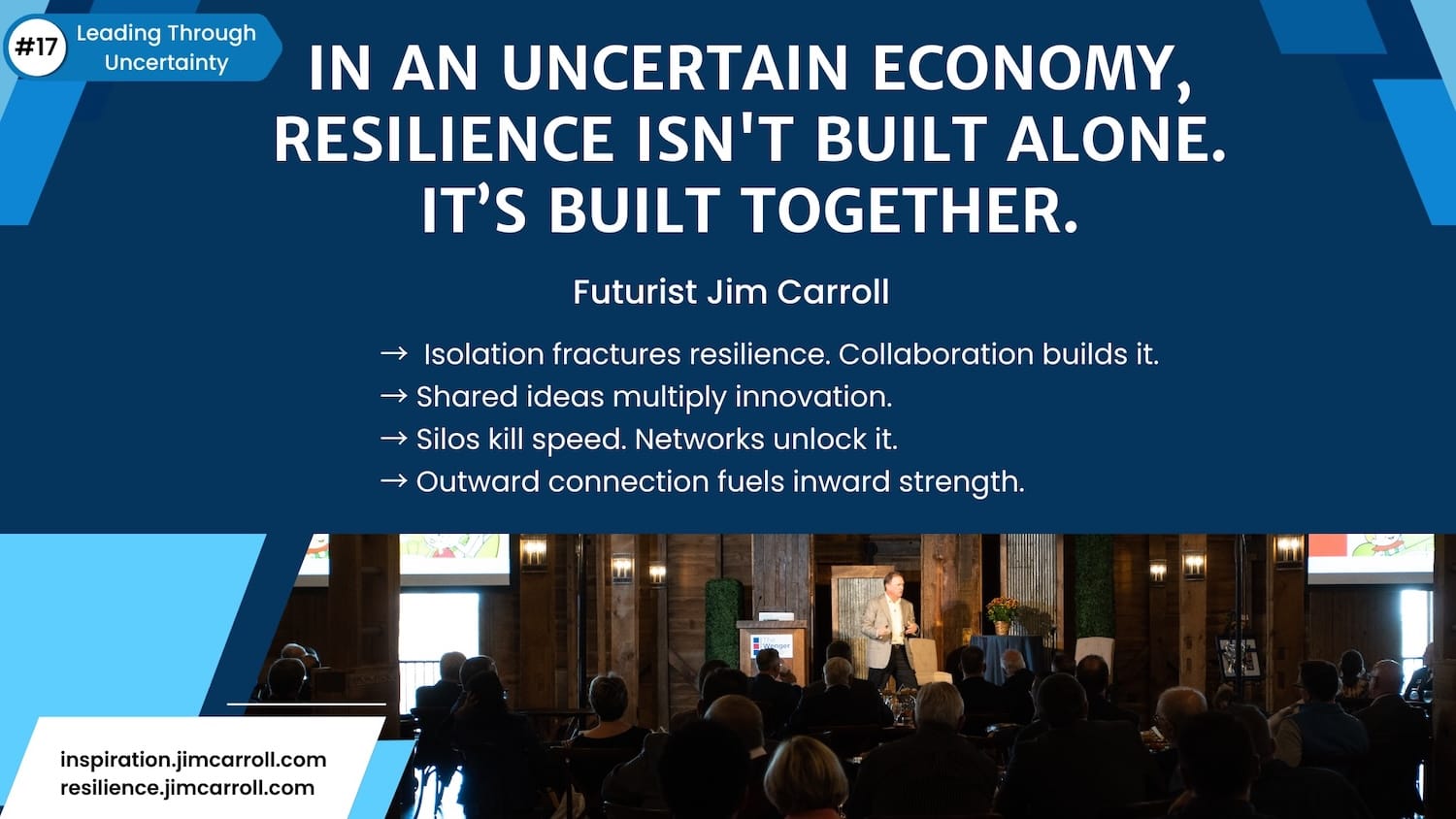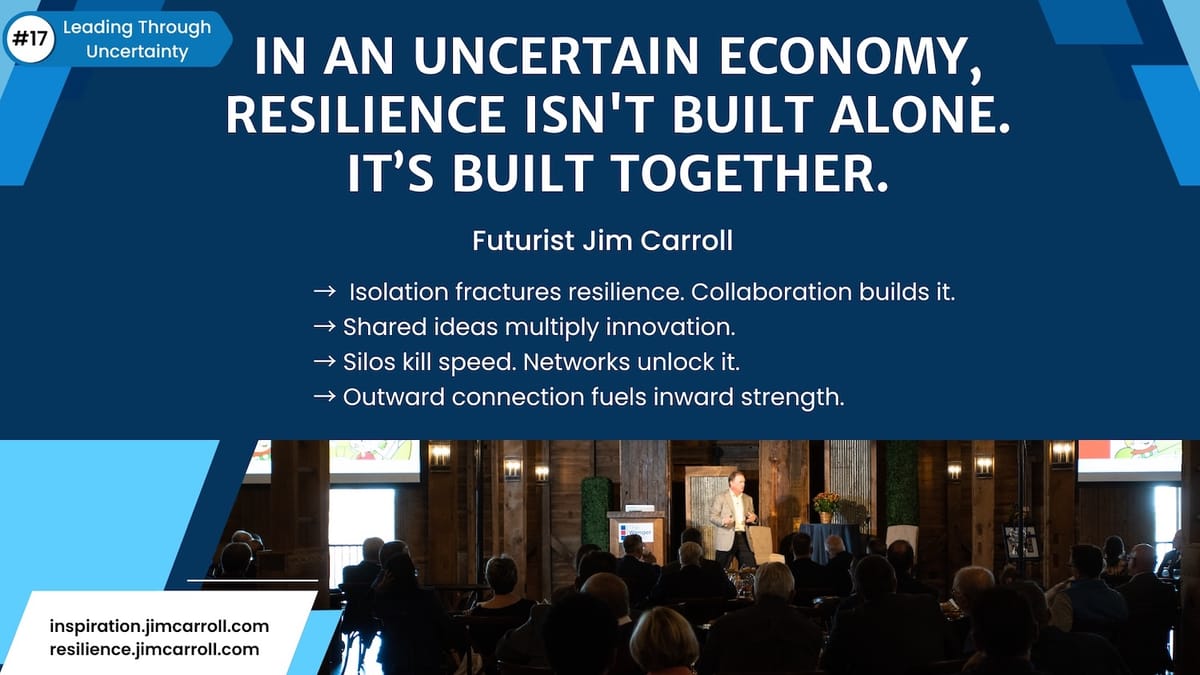"In an uncertain economy, resilience isn't built alone. It’s built together." - Futurist Jim Carroll

This is post #17 of what will be a 20-post series on how to innovate during a recession. And, as I've mentioned, it's becoming a book! Yesterday I started formatting the material so far into chapters, and it looks like I'll be coming in at about 120-130 pages. I'll finish the last post next Monday, and from that point, will work to pull together the final product. It will still take some time to get it to print, but I'm excited!
I've long shared this quote on stage: "If I have an idea and you have an idea, we have two ideas. If we share those ideas, we have a movement."

That's the power of collaboration - something that is one of the most important hidden assets of any organization.
And, you know what I am going to say - in an economic downturn, this becomes more important than ever before. It becomes a battle of collaboration vs. isolation, with a simple reality that while crises make teams turn inward, their outward connection creates resilience. Organizations that build stronger networks during downturns emerge stronger, faster, and future-ready.
Why is that? Ideas are currency, fuel for recovery, and the more ideas flow, the more collaborative thinking flows. That's why in volatility, connection beats isolation. And yet, economic volatility often triggers a dangerous instinct: retreat. Organizations turn inward, teams break into silos, and collaboration shrinks - and as a result, creativity suffocates and the idea factory slows down or worse, stops.
But if history has shown us anything, it’s this: organizations that lean outward—toward partnerships, extended idea ecosystems, and shared ideas—are the ones that not only survive uncertainty but surge ahead when recovery comes.
The fact is that isolation fractures resilience. Collaboration builds it. So the most important thing you can be doing right now is to build your collaborative spirit.
Here’s what resilient, forward-looking organizations do during periods of uncertainty. They:
- break silos: They shatter internal barriers with radical transparency and cross-functional teams.
- forge partnerships: They build new alliances and ecosystems to solve shared problems faster.
- leverage external ideas: They tap into crowdsourcing, open innovation, and “knowledge farming” for fresh insights.
- establish cross-industry boundaries: They encourage collaboration not just within their industry, but across disciplines.
- prioritize shared success: They foster a mindset where growth is collective—not just internal survival.
They build bridges when everyone else builds walls, knowing that it's critical to keep their idea machine running. Quite simply, shared ideas power future growth. Innovation doesn’t happen in isolation. It happens at the intersections of shared thought. I've shared this idea from the sage many times - world-class innovators understand:
- innovative organizations have cultures where ideas flow freely across teams and silos.
- the "infinite idea loop" which I mentioned yesterday - a global flood of new knowledge, insights, and thinking - is always running, and smart companies are always tapping into it.
- future growth will come from those who plug into this global innovation machine—not from those who try to invent everything themselves.
- the source of great ideas is shifting outward: open innovation, crowdsourcing, partnerships, and community networks.
- companies that rely only on internal R&D fall behind, while those who collaborate across boundaries leap ahead.
- collaboration with the edges is critical, as innovation increasingly occurs at the fringes, in spaces between industries, through unexpected partnerships.
- it's not just the edges but collaboration with other organizations matters - organizations must embrace external creativity—and recognize they can't master everything internally.
There's no reason all this has to stop because of economic challenges! Building a collaborative culture internally, where every team member shares insight, is a critical asset. In a downturn, it's a necessity, because it's important to start focusing on what comes next. Building on that collaboration - the sharing of community knowledge - will keep everyone ahead of trends—and fuel the collective innovation necessary to get to tomorrow.
The simple fact is that innovation thrives when ideas are shared, combined, and multiplied—not hoarded. Isolation Is a risk. Collaboration Is a competitive edge.
And in every major downturn, the companies that isolated themselves struggled to adapt as they came out the other side.
The companies that built networks, forged partnerships, and tapped into the idea economy?
They came out faster, stronger, and smarter.
When fear makes others shrink inward—lean outward.
Because in today’s economy, resilience isn't built alone.
It’s built together.
Collaboration is one of The 6 C’s of Creativity, an innovation structure that Futurist Jim Carroll often shares on stage. The 6 C’s of Creativity makes an appearance in the other book Jim is working on, Being Unique.

